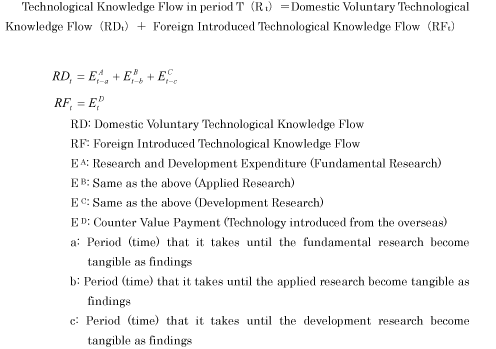Appended Note 3-5 Calculation Method for the Technological Knowledge Flow and Stock
- Japanese
- English
The following technological progress in production activities are considered from the viewpoint of technology/knowledge accumulated ( "Technological Knowledge Stock" as stated below), which is the achievement that the enterprises had been continuously performing research and development.
1. As for the input to research and development that enterprises performed in a year, the findings become tangible after several years pass for a gestation period.
By defining such a process on this presumption, we estimated the tangible results as follows ( "Technological Knowledge Flow" as stated below).

- Research and development expenditure and counter value payment are from the data of the "Science and Technology Study Report" , Ministry of Public Management, Home Affairs, Posts and Telecommunications. Besides, the fundamental research, applied research and development research are defined on the basis of the "Science and Technology Research and Report" .
- With regard to a, b and c, we referred to the "Survey for Strengthening Industrial Technology" (1998), Japan Business Federation (Nippon Keidanren); the "Questionnaire Survey on the Study Development of Private Enterprise" (1987), Institute for business investment, Development Bank of Japan. According to the former, we can obtain the development lead time by industry in 1998 (supposed as current year), five-year before, and ten-year before, respectively but there are trends that the lead time has shortened in many industries. Thereby, the annual values were estimated by using the linear regression for the values by industry at the three different stages. According to the latter, we could obtain periods by fundamental/applied/development research and by industry in the year of 1987 and then we calculated annual values for a, b, and c by industry by using the above year (1987) as a benchmark year and annual values calculated from the former.
- In regard to E A, E B and E C , given that each figure such as a, b and c shows the number of years, the unit of the decimal, for example, in the case that a = ai + aj (ai is the portion of the integer and aj is the portion of decimal), we calculated the equation as follows:

- As for the domestic voluntary technological knowledge flow, the research and development expenditure was converted to real terms by the 1990 Year Basis Study Development deflator. As for the Foreign Introduced Technological Knowledge Flow, the new contract of the counter valued payment was converted to real terms by the current year deflator and that the continued contract was converted to real terms by taking the average number (6 years) of contract years into account.
2. The Technological knowledge flow stock was estimated on the basis of the technological knowledge flow calculated in the part 1.
- T period technological knowledge stock, RS t can be expressed below, if it is given that the obsolete rate for the technological knowledge is
 .
.

- We estimated the obsolete rate for technological knowledge (
 ) by using the number of life cycle years for manufactured goods in 1998 (supposed as current year), the five-years before, and the ten-years before that can be obtained from the Keidanren' s study as described before.
The obsolete rate for the technological knowledge stock was dealt with in the same method as the diminishing-balance depreciation (supposed that the residual value with obsolescence is 10 % of the cost). That is, if it is given that the number of life cycle years for manufactured goods is n, the obsolete rate is as follows:
) by using the number of life cycle years for manufactured goods in 1998 (supposed as current year), the five-years before, and the ten-years before that can be obtained from the Keidanren' s study as described before.
The obsolete rate for the technological knowledge stock was dealt with in the same method as the diminishing-balance depreciation (supposed that the residual value with obsolescence is 10 % of the cost). That is, if it is given that the number of life cycle years for manufactured goods is n, the obsolete rate is as follows:
Since the life cycle for manufactured goods has shortened in many industries, it is considered that the rate of is increasing in the medium term. Thereby, the annual rates of
is increasing in the medium term. Thereby, the annual rates of at the three different stages as stated above were calculated by using the linear regression method.
at the three different stages as stated above were calculated by using the linear regression method. - The value of RS benchmark was calculated by using the growth rate of R for the average of the three years after 1974 and the obsolete rate of
 .
Reference materials: Business Investment Study ' 84, Institute for Business Investment, Development Bank of Japan, Economic Management Study, July 1984; Japan' s Technological Development and Trade Structure, Development Bank of Japan, Survey, No.241, June 1998
.
Reference materials: Business Investment Study ' 84, Institute for Business Investment, Development Bank of Japan, Economic Management Study, July 1984; Japan' s Technological Development and Trade Structure, Development Bank of Japan, Survey, No.241, June 1998
